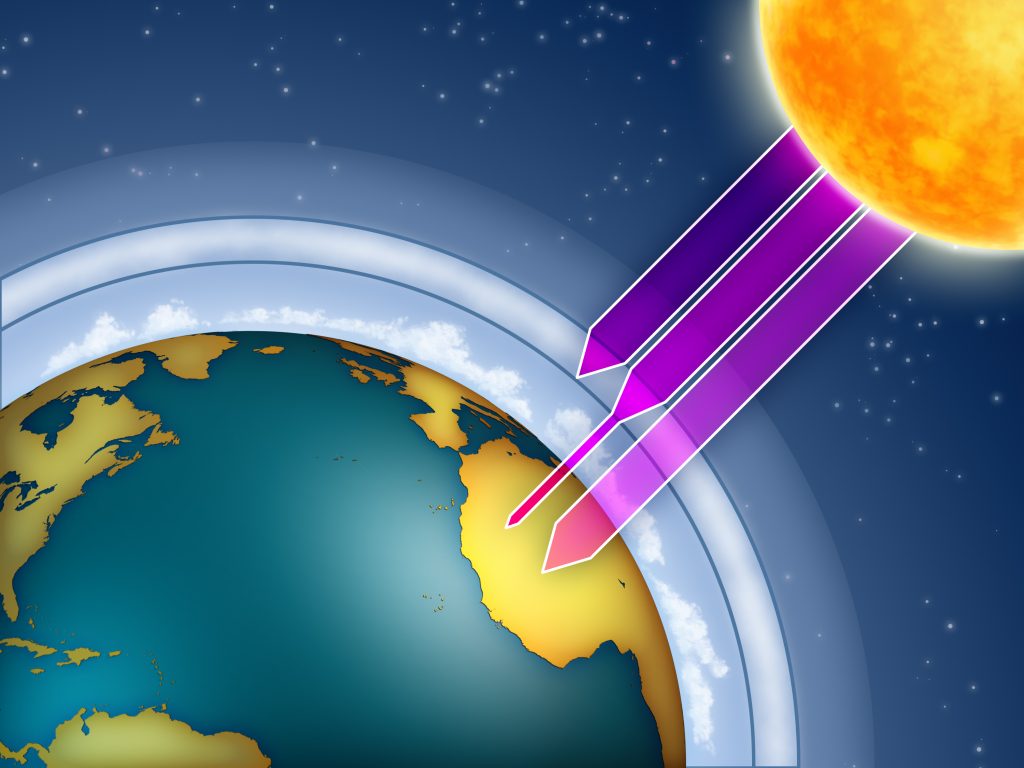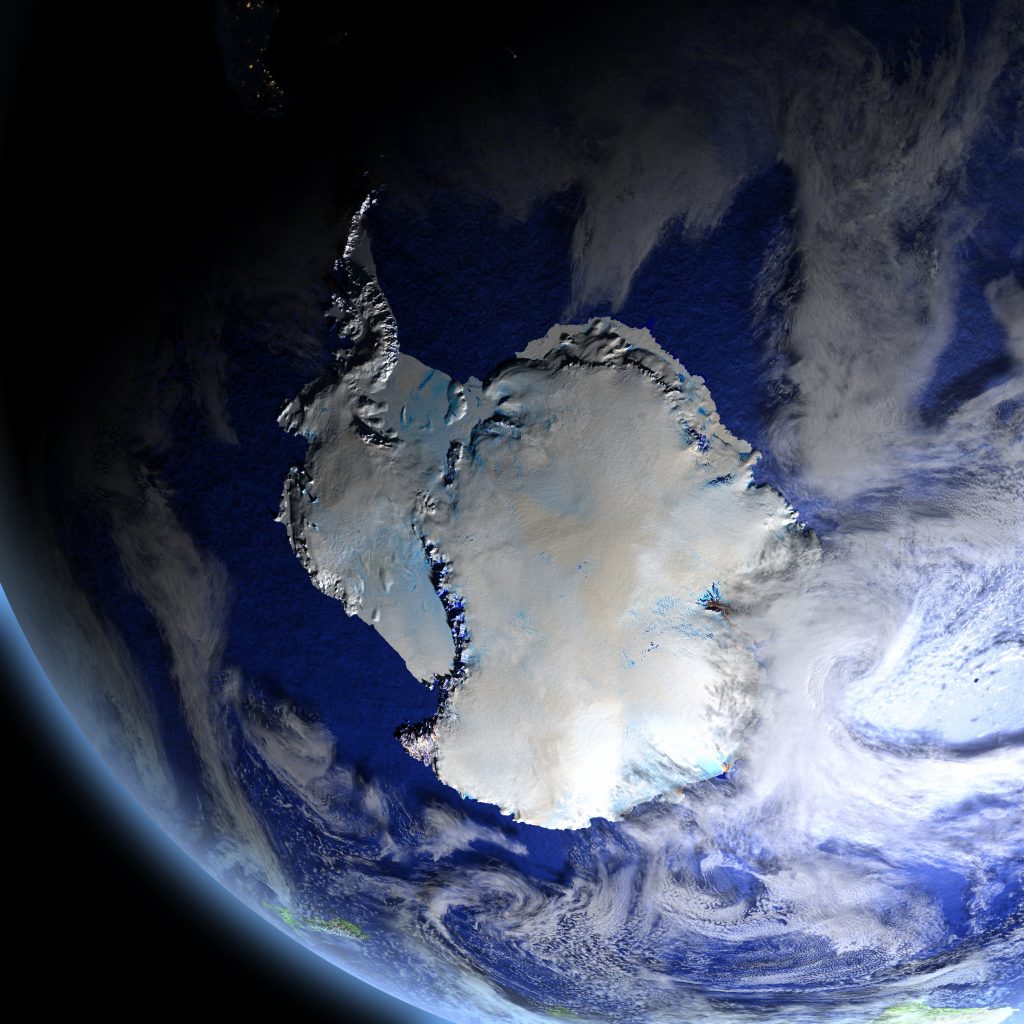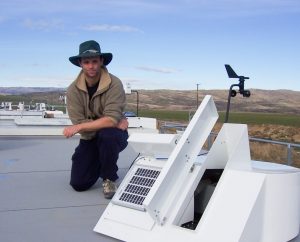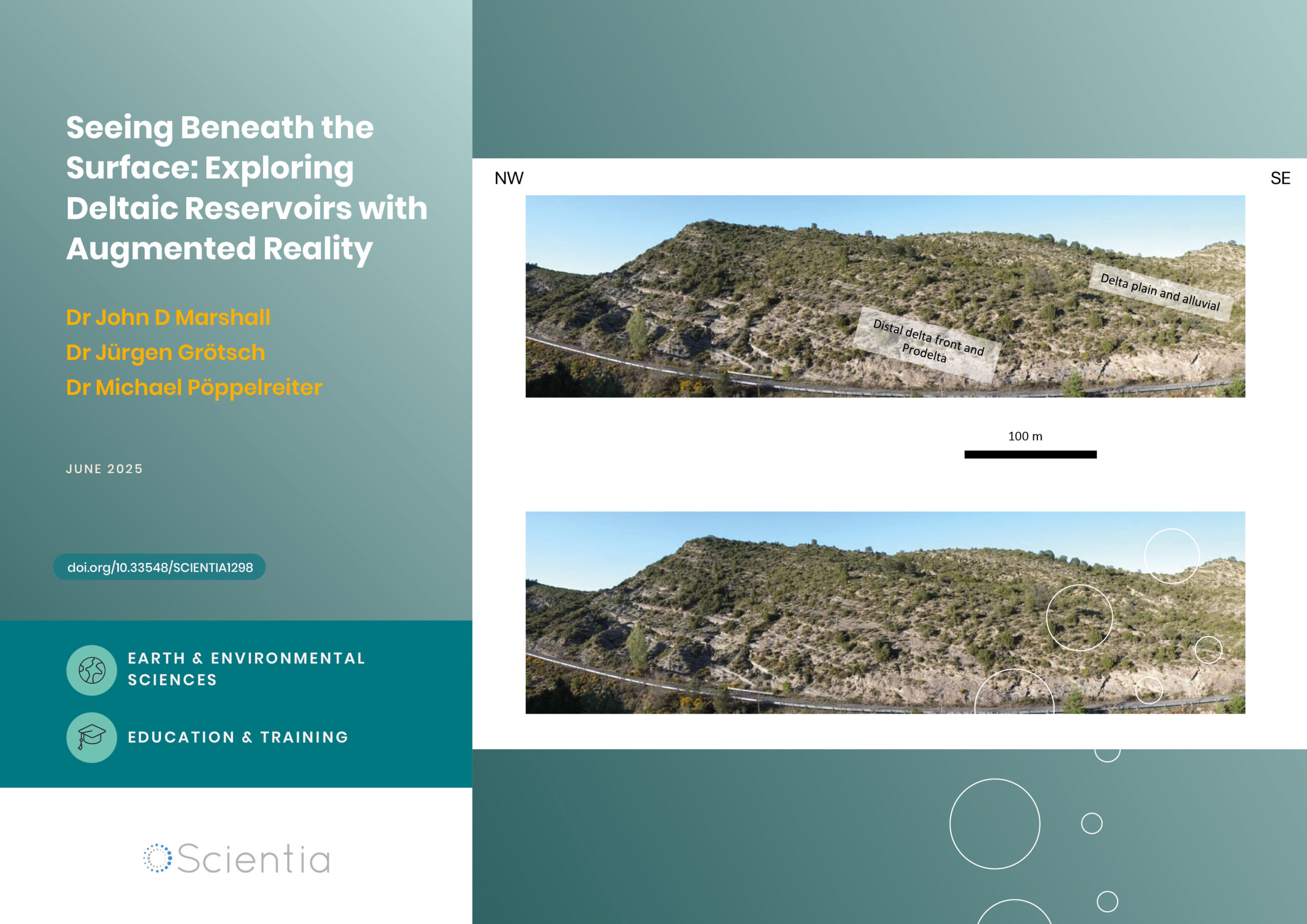Dr Susan Strahan | Dan Smale – Predicting the Health of the Ozone Layer to Ensure its Protection
The phasing out of ozone-depleting gases has set the ozone layer on the road to recovery. However, atmospheric changes wrought by rising greenhouse gas levels may represent a new threat to Earth’s protective shield. Dr Susan Strahan from the NASA Goddard Space Flight Center and Dan Smale from the National Institute of Water and Atmospheric Research (NIWA) in New Zealand combine atmospheric measurements with simulations to track and explain recent changes to the ozone layer, towards ensuring its protection into the future.
Monitoring Ozone
The complexity of the atmosphere is considerable, and scientists continue to devote much time to further our understanding about how it functions. An increased understanding about how human activity influences the atmosphere enables governments and industries to reduce their environmental impact when making decisions.
One especially important example of a response to an environmental crisis is the Montreal Protocol. Drawn up in 1987, this protocol established a worldwide commitment to reducing the production of substances that deplete atmospheric ozone, particularly chlorofluorocarbons ‘CFCs’, which had been used for decades in air conditioners, refrigerators and aerosol sprays. By the early 1990s, the production and consumption of CFCs was completely banned in many countries.
Because of their inertness and widespread use over a long period, high levels of CFCs ultimately ended up in the atmosphere. When exposed to ultraviolet light in the upper atmosphere, these CFCs release chlorine atoms, which can then go on to break down ozone molecules. The combination of chlorine atoms and the very cold atmosphere over Antarctica in winter led to a region of severe seasonal depletion – or the ‘ozone hole’ – allowing more harmful UV radiation to reach the Earth’s surface.
Since the Montreal Protocol was conceived, scientists have been monitoring the state of the ozone layer to understand its response to reduced CFC emissions. However, rising levels of greenhouse gases, such as carbon dioxide, represent a new and poorly understood threat to atmospheric ozone. High-quality data collection, alongside atmospheric modelling, can allow scientists to build an accurate picture of how the ozone layer is changing, and how it is likely to evolve in response to further increases in greenhouse gas levels.
With their global team of scientists, Dr Susan Strahan of the Universities Space Research Association and NASA Goddard Space Flight Center in the US, and Dan Smale from the National Institute of Water and Atmospheric Research in New Zealand, are using real-world data to test whether models can accurately simulate atmospheric processes influencing the ozone layer. ‘We want the atmospheric models to be as good as they possibly can be, because we use them to predict how the ozone layer may change as levels of greenhouse gases rise,’ explains Dr Strahan. ‘The ozone layer is our planet’s sunscreen, so it’s quite important to know whether we’re doing anything to harm it.’
Dr Strahan and Smale are both members of the Network for the Detection of Atmospheric Composition Change (NDACC), a global collaboration between scientists created in 1991. NDACC’s primary objective is to create global long‐term records of high-quality atmospheric composition in order to detect trends. Smale is a Principal Investigator of one of the NDACC instrument working groups and Dr Strahan is a member of the NDACC Steering Committee who provides model simulations that support analysis of NDACC observations.

Experiments First, Models Second
Over the past few years, Dr Strahan and her collaborators have published observational evidence and modelling research showing that the ozone hole is healing. This research was challenging, as CFCs can linger in the atmosphere for decades, making it difficult to identify clear signs of ozone recovery. Eventually, the team demonstrated how the reduction in chlorine levels (released from CFCs) correlated with the extent to which ozone was recovering. Interestingly, the increase in ozone levels is greatest near the edges rather than the centre of the hole.
‘Using model simulations and measurements of the chemical composition of the ozone hole over the past three decades, we now know that the Montreal Protocol has been a success,’ says Dr Strahan. ‘The ozone hole is shrinking and it’s because levels of ozone-depleting substances are declining. We wouldn’t know this without models and measurements working together.’
For decades, Dr Strahan has used high-quality observational data, such as those collected by Smale, to improve the accuracy of atmospheric chemical models that simulate the past. Those improvements, along with computational advances and more sophisticated weather models, have made it possible to develop a robust model that describes the chemical state of the atmosphere at a given location and point in time in the recent past.
The improved chemistry in this model can then be used in climate models that make predictions of future scenarios. For example, Dr Strahan can input variables that describe expected future levels of carbon dioxide, and then find out how this greenhouse gas will affect atmospheric circulation, which may damage the ozone layer. ‘Such predictions are tricky because there are competing effects,’ she explains. ‘While carbon dioxide is increasing, the CFCs that destroy ozone are also greenhouse gases and they are decreasing.’
Dr Strahan, Smale and other researchers in the field present their combined results in documents such as the ‘Scientific Assessment of the Ozone Layer’, which is published by the World Meteorological Organization (WMO). This document is used by policymakers and industry leaders to make informed decisions about how to minimise any future impacts on atmospheric ozone. As such, it is vital that the models are reliable and that any discrepancies with real-world findings are rectified. ‘Measurements provide critical feedback to models, showing us what the models are getting right and where improvements are needed,’ says Dr Strahan.
However, different research groups publish work based on different models, which don’t always lead to the same conclusions. These differences introduce doubt and undermine the credibility of atmospheric models and their subsequent recommendations. These conflicting issues are one of the focal points of Dr Strahan’s latest research.
Modelling Atmospheric Chemistry
Dr Strahan focuses on a type of model known as a Chemistry Transport Model, or CTM. CTMs utilise meteorological analyses, produced by the same models that predict the weather – which assimilate temperature, humidity, wind speed, and other data measured at locations spread out over the Earth’s atmosphere. The meteorological analyses are able to accurately model other unexplored regions, filling in the blanks, and thus yield an overview of the state of the entire atmosphere with remarkable accuracy. Using these analyses, the CTM then calculates the global chemical composition.
‘CTMs allow us to “look under the hood” and see in detail how the atmosphere has been evolving over the past 30 or so years,’ Dr Strahan explains. ‘This is about how long we’ve had meteorological analyses good enough to do this kind of work.’ However, CTMs only represent sequences of events that have already occurred. To forecast future atmospheric composition, the chemistry provided by CTMs is used in climate models, such as Chemical Climate Models (CCMs).
CCMs make predictions by applying fundamental physical laws that govern the behaviour of energy and matter in the atmosphere. If a CCM consistently produces changes in chemical composition and meteorology similar to what has been observed in the past, then it may reliably predict results for a future date. Like all models, however, CCMs are not perfect and do not consider all factors. Specifically, CCMs do not fully accommodate the effect of minor atmospheric motion, which can have a significant influence on how energy and matter are distributed. Additionally, many CCMs do not include the oceans. This can greatly affect predictions, considering that significant heat exchange occurs between the atmosphere and ocean.
‘Studies using CCMs try to predict how atmospheric composition will change in the future as greenhouse gases increase and CFCs decline,’ describes Dr Strahan. ‘We try our best to make CCMs that generate realistic meteorology, but they have shortcomings. For example, we know that they are unable to produce as much composition variability as we observe in the ozone layer and this is because CCMs can’t represent all the small-scale waves that are important drivers of atmospheric motions. This can lead to errors predicting atmospheric circulation trends in the future, thereby impacting ozone predictions.’

Discrepancies Between Simulations
One example that illustrates the discrepancies between simulations is about how the so-called ‘age of air’ across each hemisphere has changed. Gases emitted from the ground can migrate to the stratosphere, where the ozone layer resides, and back down to the lower atmosphere. The average time taken for air to travel from the Earth’s surface to the stratosphere is known as the average age of air. This value is not measured directly but inferred from trace gas and meteorological data.
Dr Strahan and Smale performed an analysis of 25 years’ worth of NDACC nitric acid and hydrogen chloride observations in the atmosphere. Their analysis indicated that the time air spends in the stratosphere in the southern hemisphere is decreasing with respect to that in the northern hemisphere. A parallel analysis of the CTM over the same time period produced very similar results, allowing them to look inside the model to learn additional details of how atmospheric chemistry and meteorology were changing. These results contrast with most CCM studies, some of which predict the opposite change, while many predict a decrease in the travel time in both hemispheres.
The circulation of air can influence the distribution of ozone and CFCs across the stratosphere, and so it is important to model the circulation accurately. The differences between CTM and CCM results are a concern because climate scientists use CCMs to predict the future state of the ozone layer.
When Strahan, Smale and their team zoomed in on the 25-year trend line, they noticed that the line was not straight, but oscillated over a five-year period – a feature not produced by the CCMs. The oscillation indicated that the age of air trends in both hemispheres seesaws over periods of about five years. This may explain the different conclusions given by other reports that used shorter data records.
Over a longer period of 25 years, the team noticed an overall trend showing that the age of air in the southern hemisphere was getting younger relative to the northern hemisphere. But the trend was small and required a long data record in order to see beyond the oscillations. Consequently, the team recommended in their report that all trend analyses examine observations spanning a time period of at least 20 years to avoid bias due to the oscillations. The team proposed that the oscillating nature of the trend line was a result of the interaction between the oscillating easterly and westerly winds near the equator and the circulation of air from the warmer tropical regions to the poles. CCMs are known to struggle to realistically produce these oscillating winds, which may explain their inability to match the observations.
The work of Dr Strahan, Smale and their colleagues demonstrates the need to constantly improve models by testing them with real-world data, so that they yield reliable predictions. Long-term measurement networks such as NDACC play an essential role in filling this need. The end goal of their efforts will instil more confidence in the models and help global leaders make better informed decisions, towards protecting the ozone layer in the face of rising greenhouse gases.
Reference
https://doi.org/10.33548/SCIENTIA671
Meet the researchers

Dr Susan Strahan
Universities Space Research Association
NASA Goddard Space Flight Center
Greenbelt, MD
USA
Dr Susan Strahan received her PhD in Chemistry from University of California, Berkeley in 1986. She is currently a Principal Scientist for the Universities Space Research Association at NASA Goddard Space Flight Center. Here, she uses models and measurements to learn how chemistry and meteorology affect the ozone layer. Dr Strahan’s research focuses on the analysis of satellite and ground‐based trace gas data sets with the goals of improving the understanding of atmospheric transport processes and their representation in models. Her contributions have been recognised with multiple prestigious awards, including the GESTAR award for Exceptional Contribution in Stratospheric Research in both 2016 and 2018.
See this video for information on Earth Science Research at NASA Goddard Space Flight Center.
CONTACT
E: susan.e.strahan@nasa.gov
W: https://www.usra.edu/people/susan-strahan

Dan Smale
National Institute of Water and Atmospheric Research (NIWA)
Lauder, Central Otago
New Zealand
Dan Smale received his MSc in physics from the University of Auckland in New Zealand in 2001. He is currently a Principal Atmospheric Technician at NIWA, where he is involved in instrument design, operation and data analysis. As part of his role, Smale spends three weeks a year visiting Scott Base training the Antarctica New Zealand’s science technicians to operate NIWA’s equipment. He is also the principal investigator for the remote sensing trace gas measurement programmes at Lauder and Scott Base, and responsible for the greenhouse gas measurement project at Lauder.
See this video for information on NIWA.
CONTACT
E: dan.smale@niwa.co.nz
W: https://niwa.co.nz/people/dan-smale
KEY COLLABORATORS
Dr Anne Douglass, NASA Goddard Space Flight Center (retired)
Megan Damon, Science Systems Applications Inc., NASA Goddard Space Flight Center
Stephen Steenrod, Universities Space Research Association, NASA Goddard Space Flight Center
John Robinson, NIWA
FUNDING
NASA Modeling Analysis and Prediction Program
NASA Atmospheric Composition Modeling and Analysis Program
NIWA
New Zealand’s Ministry of Business, Innovation and Employment Strategic Science Investment Fund
FURTHER READING
SE Strahan, D Smale, AR Douglass, T Blumenstock, JW Hannigan, F Hase, NB Jones, E Mahieu, J Notholt, LD Oman, I Ortega, M Palm, M Prignon, J Robinson, M Schneider, R Sussmann, VA Velazco, Observed hemispheric asymmetry in stratospheric transport trends from 1994 to 2018, Geophysical Research Letters, 2020, 47.
SE Strahan, AR Douglass, MR Damon, Why do Antarctic ozone recovery trends vary?, Journal of Geophysical Research: Atmospheres, 2019, 124, 8837.
SE Strahan, AR Douglass, Decline in Antarctic ozone depletion and lower stratospheric chlorine determined from Aura Microwave Limb Sounder observations, Geophysical Research Letters, 2018, 45, 382.



Want to republish our articles?
We encourage all formats of sharing and republishing of our articles. Whether you want to host on your website, publication or blog, we welcome this. Find out more
Creative Commons Licence
(CC BY 4.0)
This work is licensed under a Creative Commons Attribution 4.0 International License. 
What does this mean?
Share: You can copy and redistribute the material in any medium or format
Adapt: You can change, and build upon the material for any purpose, even commercially.
Credit: You must give appropriate credit, provide a link to the license, and indicate if changes were made.
More articles you may like
How Food Environments Shape Our Eating Habits
How we eat dramatically impacts our health, yet millions of Americans live in ‘food deserts’ – areas with limited access to fresh, nutritious food. Recent research reveals that solving this crisis requires looking beyond just physical access to food to understand how our entire community environment shapes our dietary choices. Through a series of pioneering studies, Dr Terrence Thomas and colleagues at North Carolina A&T State University have been investigating how different aspects of our food environment influence what we put on our plates. Their findings suggest that creating lasting change requires reimagining how communities engage with food at every level.
Probing Electron Dynamics in the Ultrafast Regime
In the atoms that make up the matter around us, negatively charged particles called electrons have properties such as spin and orbital angular momentum. Researchers at Martin Luther University Halle-Wittenberg have developed a theoretical framework which allows them to simulate the dynamics of the spin and orbital angular momentum of electrons in materials when probed with an ultrafast laser pulse. Using this framework, they are able to simulate different materials and improve our understanding of dynamics on an atomic scale.
Seeing Beneath the Surface: Exploring Deltaic Reservoirs with Augmented Reality
In the Aínsa Basin of the Spanish Pyrenees, the Mondot-1 well was drilled, cored, and fully logged to capture a detailed record of a long-buried ancient river delta system. Dr. John D. Marshall, Dr. Jürgen Grötsch, and Dr. Michael C. Pöppelreiter with co-workers at Shell International used this core to trace how sediments once flowed across the landscape, and were deposited under shifting tectonic conditions. The team employed augmented reality and interactive virtual displays; these innovative tools offer new ways to explore subsurface depositional systems, and are particularly useful in locations where physical access to the core is difficult, or no longer possible.
Dr Jim Wu | Ziresovir Offers New Hope for Treating Respiratory Syncytial Virus Infections
Respiratory syncytial virus (RSV) causes respiratory tract infections in children and adults. While for many patients the outcomes of infection are mild, for others, infection can prove fatal, and there is a lack of effective treatments. Dr Jim Wu from the Shanghai Ark Biopharmaceutical Company in China carries out his vital research to develop new, safe, and effective treatments to tackle this killer.




